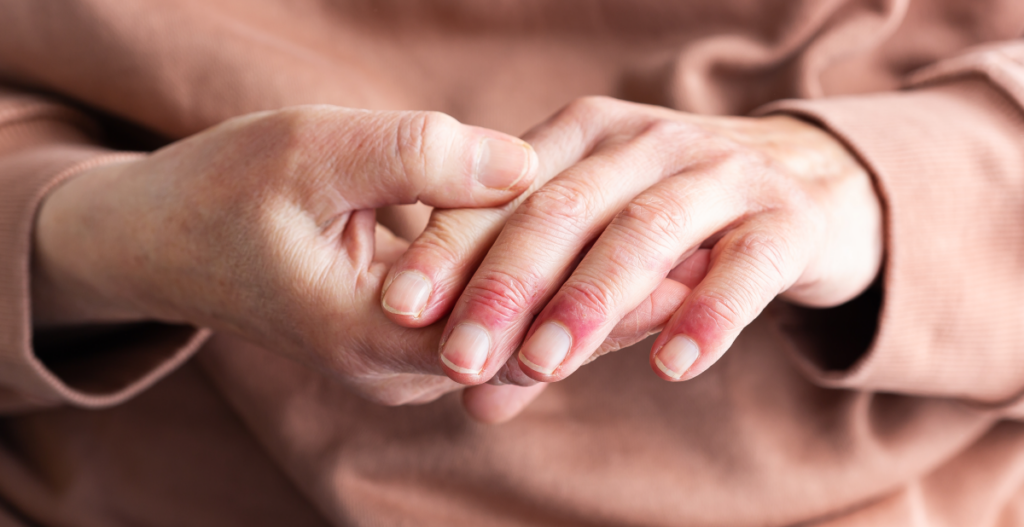Your skin has its own language. He sends you signs and tells you what’s going on without saying a word. Redness, itching, eczema… Atopic dermatitis can manifest itself in many ways. But what exactly is this condition and how can it be treated?
Join us as we explore the world of atopic dermatitis with our expert Albert Navasa, ISDIN Medical Marketing Specialist.
What is atopic dermatitis?
Albert Navasa helps us understand the term: “Simply put, atopic dermatitis, commonly known as eczema, is a chronic inflammatory disease that causes dryness, itching and inflammation of the skin.” Although it is more common in young children, it can occur at any age, with 1 in 10 people experience it at some point in their life.1
While it is the most common pediatric skin condition, the causes of atopic dermatitis include several factors. Genetic predisposition tops the list, followed by environmental, allergenic and dietary triggers.
Recognizing the signs
Atopic dermatitis is known for its sudden onset, often appearing anywhere on the body as small, itchy bumps or rashes. Everyone experiences it differently and symptoms can vary greatly from one person to another. Common signs include:
- Dry, cracked skin
- Persistent itching
- Rashes, which can vary in color depending on skin tone
- Spot formation
- Increased skin sensitivity
- Darkening of the skin around the eyes
In people with darker skin tones, it can also appear as small raised bumps. It’s important to remember that while many people with atopic dermatitis may experience similar symptoms, they can also be caused by something else: “To accurately diagnose atopic dermatitis, it’s best to see a dermatologist,” advises Albert.
Knowledge is power
Living with a skin condition can be frustrating, but the good news is that atopic dermatitis is not serious. In fact, it’s a benign condition that’s more common than you might think.
Have you ever heard of eczema? Albert explains the connection: “Eczema is the general term for skin conditions that cause swelling and itching. Atopic dermatitis is the most common form of eczema.”
This condition is mainly characterized by dry skin. And while it can be uncomfortable, Albert points it out Atopic dermatitis is not contagious.
“Atopic dermatitis is not contagious.”
– Albert Navasa, Corporate Medical Marketing Specialist

Who does it affect?
A common belief is that only children get atopic dermatitis, but it can actually affect people of any age. Albert clears up this misconception: “The truth is, you can develop this skin condition at any stage of your life.”
About 25% of children will experience this condition at some point, while it affects 7-10% of adults.2 In children, atopic dermatitis usually flares up on the face, in the folds of the elbows and knees, on the legs, and even on the scalp. In adults, it can appear anywhere from head to toe!
One thing both children and adults share is the range of symptoms: from mild to severe itching and skin lesions that often result from the inevitable scratching.
Start time
There is no way to predict when atopic dermatitis will appear, as it can appear—or not—at any point in someone’s life. It can also be caused or aggravated by factors such as stress, poor dietary choices, or using skincare products that aren’t quite right for you.
So, what’s your best defense? Take preventative measures to nourish and protect your skin.

How to care for atopic skin
Albert emphasizes that the first rule of thumb in managing atopic dermatitis is to avoid anything that makes your skin worse, such as products that cause irritation or reactions. It’s also important to have a game plan for managing flare-ups and relieving itching. Here is the breakdown:
- Keep your nails short: This simple tip will help you resist the urge to scratch — or at least make scratching less intense!
- Reduce your shower time: Aim for less than ten minutes and avoid hot, steamy showers, as hot water can strip your skin of its natural oils and potentially cause irritation. Choose gentle pH-balanced products with natural ingredients, such as oatmeal.
- Be gentle when drying: Gently dab your skin with a towel instead of scrubbing.
- Use moisturizing creams or lotions: It is important to keep your skin well hydrated and refreshed. Remember: Consistency is key!
- Wash new clothes and avoid harsh fabrics (this includes wardrobe and bedding): Go for cotton, especially for items that come in direct contact with your skin.
- Consider using specific treatments and products for the condition — always under the guidance and recommendation of a dermatologist.
Expert advice: While our medical experts have contributed and verified the information in this post, there are other official atopic dermatitis resources available. Check out the following websites to learn more about this skin condition:
→ National Eczema Association
→ American Academy of Dermatology (AAD)
→ American Academy of Pediatrics (AAP)
Love every inch of your skin
Although there is no cure for eczema, many children see their symptoms improve as they get older, while some adults experience flare-ups that come and go. This is completely normal because our skin, like life, has its ups and downs.
The secret to healthy skin lies in the choices we make every day. It’s often the simple rituals we incorporate into our routines that have the most profound impact, not only on our overall well-being, but also on the overall health of our skin.
→ Make an annual appointment with your dermatologist.
→ Do your best to keep stress at bay.
→ Follow a nutritious diet.
→ Make adequate sleep a priority.

Bibliographical references:
- Frazier W, Bhardwaj N. Atopic Dermatitis: Diagnosis and Treatment. Am Fam Physician. 2020 May 15, 101(10):590-598.
- Avena-Woods C. Overview of atopic dermatitis. Am J Manag Care. 2017 Jun;23(8 Suppl):S115-S123.
- Langan SM, Irvine AD, Weidinger S. Atopic dermatitis. Lancet. 2020 Aug 1;396(10247):345-360. doi: 10.1016/S0140-6736(20)31286-1. Erratum in: Lancet. 2020 Sep 12;396(10253):758.


